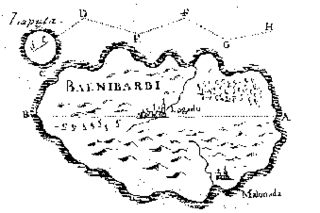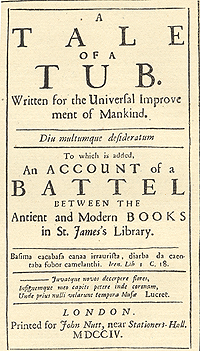
Jonathan Swift was an Anglo-Irish satirist, author, essayist, political pamphleteer, poet, and Anglican cleric who became Dean of St Patrick's Cathedral, Dublin, hence his common sobriquet, "Dean Swift".

Gulliver's Travels, or Travels into Several Remote Nations of the World. In Four Parts. By Lemuel Gulliver, First a Surgeon, and then a Captain of Several Ships is a 1726 prose satire by the Anglo-Irish writer and clergyman Jonathan Swift, satirising both human nature and the "travellers' tales" literary subgenre. It is Swift's best known full-length work, and a classic of English literature. Swift claimed that he wrote Gulliver's Travels "to vex the world rather than divert it".

Houyhnhnms are a fictional race of intelligent horses described in the last part of Jonathan Swift's satirical 1726 novel Gulliver's Travels. The name is pronounced either or. Swift apparently intended all words of the Houyhnhnm language to echo the neighing of horses.

Laputa is a flying island described in the 1726 book Gulliver's Travels by Jonathan Swift. It is about 4+1⁄2 miles in diameter, with an adamantine base, which its inhabitants can manoeuvre in any direction using magnetic levitation. The island is the home of the king of Balnibarbi and his court, and is used by the king to enforce his rule over the lands below.

John Arbuthnot FRS, often known simply as Dr Arbuthnot, was a Scottish physician, satirist and polymath in London. He is best remembered for his contributions to mathematics, his membership in the Scriblerus Club, and for inventing the figure of John Bull.

Lilliput and Blefuscu are two fictional island nations that appear in the first part of the 1726 novel Gulliver's Travels by Jonathan Swift. The two islands are neighbours in the South Indian Ocean, separated by a channel 800 yards (730 m) wide. Both are inhabited by tiny people who are about one-twelfth the height of ordinary human beings. Both are empires, i.e. realms ruled by an emperor. The capital of Lilliput is Mildendo. In some pictures, the islands are arranged like an egg, as a reference to their egg-dominated histories and cultures.

Brobdingnag is a fictional land, which is occupied by giants, in Jonathan Swift's 1726 satirical novel Gulliver's Travels. The story's main character, Lemuel Gulliver, visits the land after the ship on which he is travelling is blown off course. As a result, he becomes separated from a party exploring the unknown land. In the second preface to the book, Gulliver laments that the publisher misspelled the land's name, which Gulliver asserts is actually called Brobdingrag.

A Tale of a Tub was the first major work written by Jonathan Swift, composed between 1694 and 1697 and published in 1704. It is arguably his most difficult satire, yet considered by some to be his best. The Tale is a prose parody divided into sections of "digression" and a "tale" of three brothers, each representing one of the main branches of western Christianity. A satire on the Roman Catholic and Anglican churches and English Dissenters, it was famously attacked for its profanity and irreligion, starting with William Wotton, who wrote that it made a game of "God and Religion, Truth and Moral Honesty, Learning and Industry" to show "at the bottom [the author's] contemptible Opinion of every Thing which is called Christianity." The work continued to be regarded as an attack on religion well into the nineteenth century. One commentator complained that Swift must be "a compulsive cruiser of Dunghils … Ditches, and Common-Shores with a great Affectation [sic] for every thing that is nasty. When he spies any Objects that another Person would avoid looking on, that he Embraces.”

The Amboyna massacre was the 1623 torture and execution on Ambon Island of twenty-one men, including ten of whom were in the service of the English East India Company, and Japanese and Portuguese traders and a Portuguese man, by agents of the Dutch East India Company (VOC), on accusations of treason. It was the result of the intense rivalry between the East India companies of England and the United Provinces in the spice trade and remained a source of tension between the two nations until late in the 17th century.

Glubbdubdrib was an island of sorcerers and magicians, one of the imaginary countries visited by Lemuel Gulliver in the 1726 satirical novel Gulliver's Travels by Anglo-Irish author Jonathan Swift. The episode on Glubbdubdrib "explores the theme of humanity's progressive degeneration."

A fumi-e was a likeness of Jesus or Mary onto which the religious authorities of the Tokugawa shogunate of Japan required suspected Christians (Kirishitan) to step, in order to demonstrate that they were not members of the outlawed religion; otherwise they would be tortured or killed.

Augustan prose is somewhat ill-defined, as the definition of "Augustan" relies primarily upon changes in taste in poetry. However, the general time represented by Augustan literature saw a rise in prose writing as high literature. The essay, satire, and dialogue thrived in the age, and the English novel was truly begun as a serious art form. At the outset of the Augustan age, essays were still primarily imitative, novels were few and still dominated by the Romance, and prose was a rarely used format for satire, but, by the end of the period, the English essay was a fully formed periodical feature, novels surpassed drama as entertainment and as an outlet for serious authors, and prose was serving every conceivable function in public discourse. It is the age that most provides the transition from a court-centered and poetic literature to a more democratic, decentralized literary world of prose.

Gulliver's Travels Beyond the Moon, also known as Space Gulliver, is a 1965 Japanese animated feature that was released in Japan on March 20, 1965 and in the United States on July 23, 1966.

Lagado is a fictional city from the 1726 satirical novel Gulliver's Travels by Jonathan Swift.
Motte v Faulkner was a copyright lawsuit between Benjamin Motte and George Faulkner over who had the legal rights to publish the works of Jonathan Swift in London. This trial was one of the first to test the Statute of Anne copyright law in regards to Irish publishing independence. Although neither held the copyright to all of Swift's works, the suit became a legal struggle over Irish rights, which were eventually denied by the English courts. Faulkner, in 1735, published the Works of Jonathan Swift in Dublin. However, a few of the works were under Motte's copyright within the Kingdom of Great Britain, and when Faulkner sought to sell his book in London, Motte issued a formal complaint to Jonathan Swift and then proceeded to sue Faulkner. An injunction was issued in Motte's favor, and the book was prohibited from being sold on British soil. The basis of the law protected the rights of the author, and not the publisher, of the works, and Swift was unwilling to support a lawsuit against Faulkner. With Swift's reaction used as a basis, the lawsuit was later seen as a struggle between the rights of Irishmen to print material that were denied under English law.

Luggnagg is an island kingdom, one of the imaginary countries visited by Lemuel Gulliver in the 1726 satirical novel Gulliver's Travels by Anglo-Irish author Jonathan Swift.
"Politics vs. Literature: An Examination of Gulliver's Travels" is a critical essay published in 1946 by the English author George Orwell. The essay is a review of Gulliver's Travels with a discussion of its author Jonathan Swift. The essay first appeared in Polemic No 5 in September 1946.

Balnibarbi is a fictional land in Jonathan Swift's 1726 satirical novel Gulliver's Travels. it was visited by Lemuel Gulliver after he was rescued by the people of the flying island of Laputa.

The cultural influence of Gulliver's Travels has spanned centuries.














